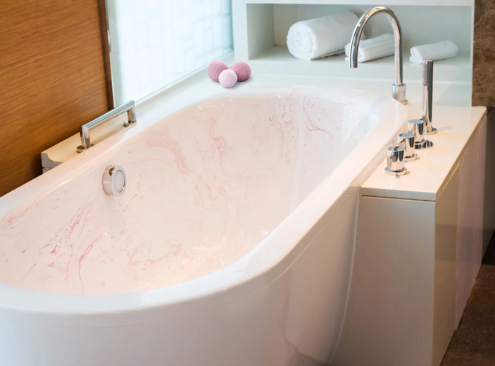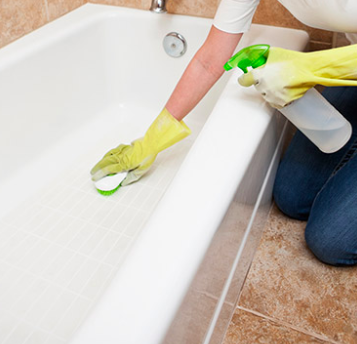Tub Spout Not Flush With Wall: Causes and Practical Solutions” delves into the reasons behind and remedies for this common issue.
Explore the causes and discover practical solutions to ensure your tub spout aligns seamlessly with the wall, enhancing both aesthetics and functionality. Dive into expert insights for a flawless fix.
Having a tub spout that is not flush with the wall can be a frustrating issue in any bathroom. Not only does it look unsightly, but it can also lead to water leakage, which can damage the surrounding walls and flooring.
In this comprehensive guide, we will explore the common causes of a tub spout not being flush with the wall and provide practical solutions to address the problem effectively.
1. Understanding the Problem
Before we delve into the causes and solutions, let’s first understand the problem. When we talk about a tub spout not being flush with the wall, we mean that the spout is not properly mounted and protrudes from the wall, leaving a visible gap between the spout and the wall surface. This misalignment can vary in degrees, from a slight tilt to a more significant gap.
2. Causes of Tub Spout Misalignment
The most common causes of tub spout misalignment include:
2.1. Incorrect Installation
One of the most common causes of a tub spout not being flush with the wall is incorrect installation. During the initial installation process, if the spout is not aligned correctly with the wall pipe or the mounting plate is not positioned accurately, it can lead to the misalignment issue.
This often happens when a DIY installation is attempted without proper knowledge or when the installer does not follow the manufacturer’s instructions.
Also Read: How to Turn On Shower With Pull Tab
Solution:
To address an incorrectly installed tub spout, you need to disassemble the spout from the wall and reinstall it properly. Carefully inspect the mounting plate and ensure it is securely attached to the wall. Make sure the wall pipe is straight and aligns with the spout’s connection point.
Use appropriate tools, such as a wrench, to tighten the spout securely. If you’re unsure about the installation process, consider hiring a professional plumber to ensure a proper and long-lasting fix.

2.2. Water Pressure
High water pressure can exert force on the tub spout, causing it to move away from the wall over time. The constant pressure can weaken the connection and gradually push the spout out of its position. If your home has consistently high water pressure, it can affect not only the tub spout but other plumbing fixtures as well.
Also Read: 10 Best Adult Diapers For Men In 2024
Solution:
To mitigate the effects of high water pressure, consider installing a pressure regulator or pressure-reducing valve. These devices help maintain a consistent and safe water pressure throughout your plumbing system.
A pressure regulator will reduce the incoming water pressure to an acceptable level, protecting your tub spout and other fixtures from unnecessary strain. This solution not only resolves the misalignment issue but also extends the lifespan of your plumbing system.
2.3. Pipe Movement
The pipes that connect to the tub spout may experience slight movements due to various factors like temperature changes, water flow fluctuations, or even house settling. These movements can cause the spout to become misaligned.
Solution:
To address pipe movements, consider securing the tub spout connection more effectively. You can use a pipe strap or additional support brackets to hold the pipe firmly in place.
This helps prevent any unintended movements that could cause the spout to shift away from the wall. If you’re unsure about how to add support, consult a plumber to ensure the proper installation of support structures.
2.4. Wear and Tear
Over time, the internal components of the tub spout can wear out, leading to misalignment. This can happen due to continuous use or low-quality materials used in the spout’s construction.
Solution:
Inspect the internal components of the tub spout regularly and look for signs of wear and tear. If you notice any damaged or worn-out parts, replace them with high-quality replacements.
Most tub spouts are designed to be easily disassembled, so carefully follow the manufacturer’s instructions for replacement. Regular maintenance and timely replacement of worn parts can prevent misalignment issues caused by wear and tear.
2.5. Improper Repairs
Previous repairs or attempts to fix a leaky tub spout might have been done improperly, causing misalignment issues. If the spout was not reinstalled correctly after repair, it can result in the spout not being flush with the wall.
Solution:
If you suspect that previous repairs were done incorrectly, it’s best to start fresh. Disassemble the tub spout and inspect the repair work that was previously done.
Check for any loose connections or improperly installed components. Correct any mistakes and reinstall the tub spout following proper installation guidelines.

3. Practical Solutions for Tub Spout Misalignment
3.1. Reinstallation
If the misalignment is due to incorrect installation, the simplest and most effective solution is to reinstall the tub spout properly.
This involves disassembling the spout from the wall, ensuring the mounting plate and wall pipe are aligned correctly, and then securing the spout back in place. Reinstalling the spout correctly eliminates the gap between the spout and the wall, ensuring a flush and secure fit.
3.2. Use of Wall Flanges
Wall flanges or escutcheons are decorative plates that can be installed behind the tub spout to cover gaps between the spout and the wall. They not only serve an aesthetic purpose but can also hide misalignments effectively.
Choose a flange that matches your bathroom decor and fits your tub spout size. Wall flanges are an easy and cost-effective way to conceal misalignments without having to disassemble and reinstall the spout.
To install a wall flange, remove the tub spout temporarily, place the flange over the pipe, and then reattach the spout over the flange. Ensure that the flange is flush against the wall, covering the gap between the spout and the wall surface. Use the appropriate tools to tighten the spout securely in place.
Also Read: 10 Best Adult Diapers For Women In 2024
3.3. Applying Silicone Caulk
If the gap between the tub spout and the wall is relatively small, you can use silicone caulk to fill it. Silicone caulk is a waterproof sealant that adheres well to various surfaces, making it an excellent choice for sealing gaps and preventing water from seeping into the wall.
To apply silicone caulk, follow these steps:
- Clean the area thoroughly to remove any dirt, grime, or old caulk.
- Cut the tip of the caulk tube at a 45-degree angle to create an opening.
- Load the caulk tube into a caulk gun.
- Apply a thin bead of caulk along the gap between the tub spout and the wall.
- Use a caulking tool or your finger to smooth out the caulk, ensuring a neat and even finish.
- Wipe away any excess caulk with a damp cloth.
- Allow the caulk to dry completely according to the manufacturer’s instructions.
Keep in mind that while caulk can effectively seal small gaps, it is not a permanent solution for significant misalignments.

3.4. Addressing Water Pressure Issues
If high water pressure is causing the spout misalignment, consider installing a pressure regulator or pressure-reducing valve.
These devices help maintain a consistent and safe water pressure, preventing excessive force on the spout and other plumbing fixtures.
To install a pressure regulator or pressure-reducing valve, you may need to hire a professional plumber, especially if you are unfamiliar with plumbing installations.
The plumber will assess your home’s water pressure and recommend the appropriate device to regulate it effectively.
3.5. Inspecting and Replacing Internal Components
If wear and tear or damaged internal components are causing the misalignment, disassemble the tub spout and inspect its parts. Replace any worn-out or damaged components with high-quality replacements before reassembling the spout.
To inspect and replace internal components, follow these steps:
- Turn off the water supply to the tub spout and drain any remaining water.
- Depending on the type of tub spout you have, remove any decorative cap or set screw that holds the spout in place.
- Gently pull the spout away from the wall, exposing the internal components.
- Examine the parts for signs of wear, corrosion, or damage.
- If you identify any faulty components, remove them and take them to a hardware store to find suitable replacements.
- Install the new components according to the manufacturer’s instructions.
- Reassemble the tub spout and secure it back onto the wall pipe.

Conclusion
A tub spout not flush with the wall can be an annoying problem, but it’s not insurmountable. By understanding the causes and implementing the practical solutions mentioned in this article, you can resolve the misalignment issue effectively.
Whether it’s a simple reinstallation or the use of wall flanges and silicone caulk, taking action promptly will not only restore the aesthetics of your bathroom but also prevent potential water damage and ensure the longevity of your tub spout.
Remember, if you’re unsure about any step or facing a complex issue, it’s best to consult a professional plumber for expert guidance and assistance.
Proper maintenance and timely repairs will keep your tub spout and plumbing system in optimal condition for years to come.







